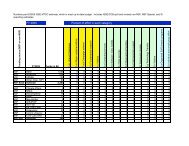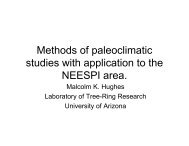The Oceanic Phosphorus Cycle
The Oceanic Phosphorus Cycle
The Oceanic Phosphorus Cycle
Create successful ePaper yourself
Turn your PDF publications into a flip-book with our unique Google optimized e-Paper software.
Contents<br />
<strong>The</strong> <strong>Oceanic</strong> <strong>Phosphorus</strong> <strong>Cycle</strong><br />
Adina Paytan* ,† and Karen McLaughlin ‡<br />
Department of Geological & Environmental Sciences, Stanford University, Stanford, California 94305-2115, and<br />
Department of Chemical Engineering & Materials Science, University of California, Irvine, Irvine, California 92697<br />
1. Introduction 563<br />
2. <strong>Phosphorus</strong> Occurrence in the Earth’s Crust 564<br />
3. <strong>Phosphorus</strong> Sources and Sinks in the Ocean 564<br />
3.1. Continental Weathering 565<br />
3.2. Anthropogenic Sources 566<br />
3.3. Atmospheric Deposition 566<br />
3.4. Marine Sediments 566<br />
3.5. Seawater−Ocean Crust Interactions 567<br />
4. <strong>Phosphorus</strong> Forms and Transformations in the<br />
Water Column<br />
567<br />
4.1. Dissolved <strong>Phosphorus</strong> in the Ocean 568<br />
4.2. Particulate <strong>Phosphorus</strong> in the Ocean 569<br />
4.3. Turnover Rates of <strong>Phosphorus</strong> in the Water<br />
Column<br />
569<br />
5. <strong>Phosphorus</strong> Forms and Transformations in the 570<br />
Sediment<br />
6. <strong>Phosphorus</strong> and Ocean Biota 570<br />
6.1. <strong>Phosphorus</strong> and Primary Production 570<br />
6.2. Utilization of Organic <strong>Phosphorus</strong> Forms 571<br />
6.3. <strong>Phosphorus</strong> Constraints on Nitrogen Fixation 572<br />
7. Microbial Role in the <strong>Phosphorus</strong> <strong>Cycle</strong> 572<br />
8. Phosphate Oxygen Isotopic Ratios: A Tracer for 573<br />
Phosphate Sources and Cycling<br />
9. Summary 573<br />
10. References 574<br />
1. Introduction<br />
<strong>Phosphorus</strong> (P) is an essential element to all life, being a<br />
structural and functional component of all organisms. 1-4 P<br />
provides the phosphate-ester backbone of DNA and RNA,<br />
and it is crucial in the transmission of chemical energy<br />
through the ATP molecule (Figure 1). P is also a structural<br />
constituent in many cell components such as phosphoproteins,<br />
and phospholipids in cell membranes, teeth, and bones<br />
(Figure 1). In some organisms it can also be present as<br />
intracellular polyphosphate storage granules (Figure 1).<br />
<strong>Phosphorus</strong> availability can impact primary production<br />
rates in the ocean as well as species distribution and<br />
ecosystem structure. 5-8 In some marine and estuarine environments,<br />
P availability is considered the proximal macronutrient<br />
that limits primary production. 8,9 Specifically, in<br />
recent years it has been recognized that phosphorus limitation<br />
in the ocean may be more prevalent than previously thought.<br />
* Corresponding author.<br />
† Stanford University. E-mail, apaytan@pangea.stanford.edu.<br />
‡ University of California, Irvine. E-mail: karenm@uci.edu.<br />
Chem. Rev. 2007, 107, 563−576<br />
10.1021/cr0503613 CCC: $65.00 © 2007 American Chemical Society<br />
Published on Web 01/27/2007<br />
563<br />
Received October 25, 2006<br />
For example, it is generally accepted that orthophosphate<br />
(PO4 3- ) is the limiting nutrient in the eastern Mediterranean<br />
Sea. 10-12 In addition, phosphate is suspected to play an<br />
important role in limiting production in the Sargasso Sea 13<br />
and may also be limiting in bodies of water receiving large<br />
freshwater inputs or fertilizer runoff from agriculture, as in<br />
the Chesapeake Bay. 14,15 Furthermore, research in the Pacific<br />
Ocean gyres indicates that biological P uptake rates far<br />
surpass the combined input from atmospheric and deep water<br />
sources, suggesting that P is efficiently recycled within<br />
oligotrophic euphotic zones. 16 It has also been suggested that<br />
transitions over the last two decades from nitrogen (N)<br />
limitation to P limitation have taken place in the North Pacific<br />
subtropical gyre and that this may be responsible for the<br />
observed succession of prokaryotic picophytoplankton such<br />
as Prochlorococcus and Synechococcus in oligotrophic<br />
waters. 6 In other marine environments, P may only be<br />
limiting a subset of organisms within the ecosystem. 17-19<br />
<strong>Phosphorus</strong>, in the form of orthophosphate, plays a key<br />
role in photosynthesis (i.e., primary productivity). <strong>The</strong><br />
chemical equation representing average ocean photosynthesis<br />
can be written as<br />
106CO2 + 16HNO3 + H3PO4 + 122H2O +<br />
light<br />
trace elements and vitamins98<br />
C106H263O110N16P + 138O2 Thus, the availability of P in marine systems can strongly<br />
influence the marine carbon cycle and the sequestration of<br />
atmospheric carbon dioxide. <strong>The</strong> “biological pump”, a<br />
process by which carbon is “pumped” from the euphotic zone<br />
to the deep ocean, exports organic carbon to depth primarily<br />
as sinking particulate material (e.g., dead organisms or fecal<br />
pellets). However, some carbon also reaches the deep ocean<br />
as dissolved organic matter (DOM) by physical transport<br />
processes such as mixing, eddy diffusion, and downwelling,<br />
and as calcium carbonate minerals. 20 Remineralization (or<br />
decomposition) processes return some of the organic carbon<br />
to dissolved carbon dioxide and regenerate nutrients within<br />
the water column. <strong>The</strong> amount of new carbon fixed during<br />
photosynthesis that is subsequently exported from the euphotic<br />
zone is known as export production. This export<br />
production can influence global climate through the sequestration<br />
of atmospheric carbon dioxide to the deep ocean. 20<br />
Unlike nitrogen, P cannot be fixed from the atmosphere.<br />
Thus, over geologic time scales, P is often considered to be<br />
the ultimate limiting macronutrient in marine ecosystems 21,22<br />
and therefore influences primary production and the sequestration<br />
of atmospheric carbon dioxide in organic matter. 23-25


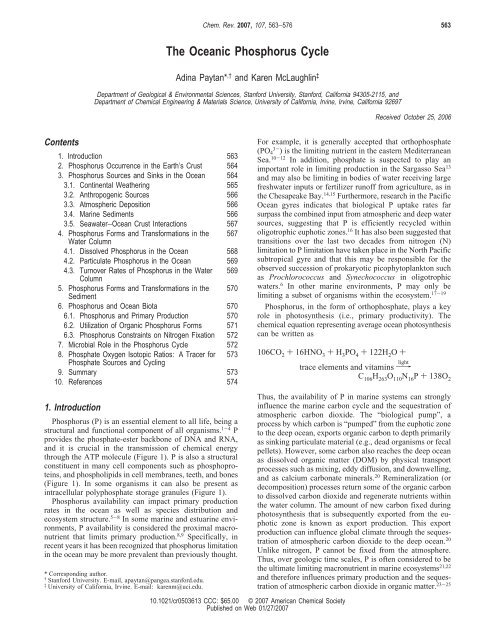
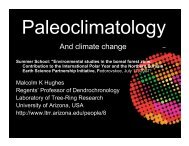


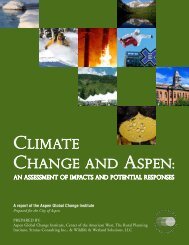

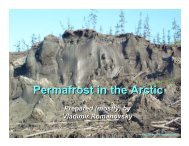
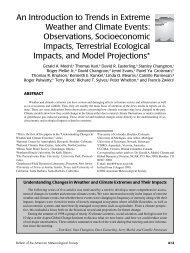
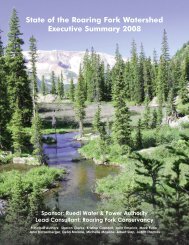
![View Powerpoint Slides [PDF]](https://img.yumpu.com/32486693/1/190x146/view-powerpoint-slides-pdf.jpg?quality=85)
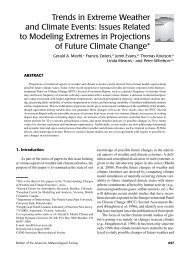


![View Powerpoint Slides [PDF]](https://img.yumpu.com/29411106/1/190x143/view-powerpoint-slides-pdf.jpg?quality=85)
